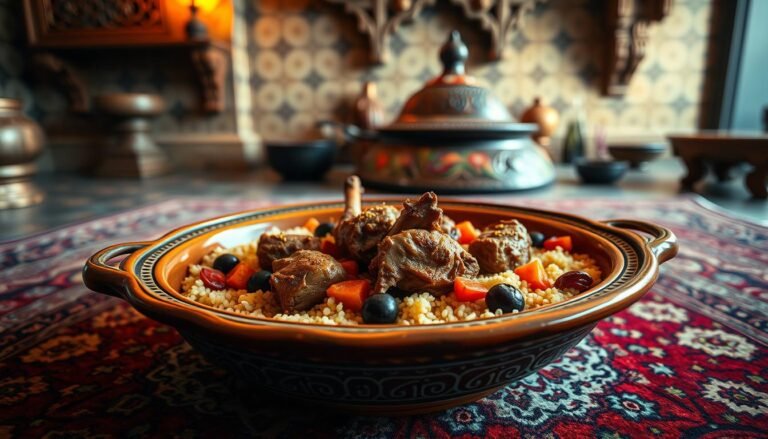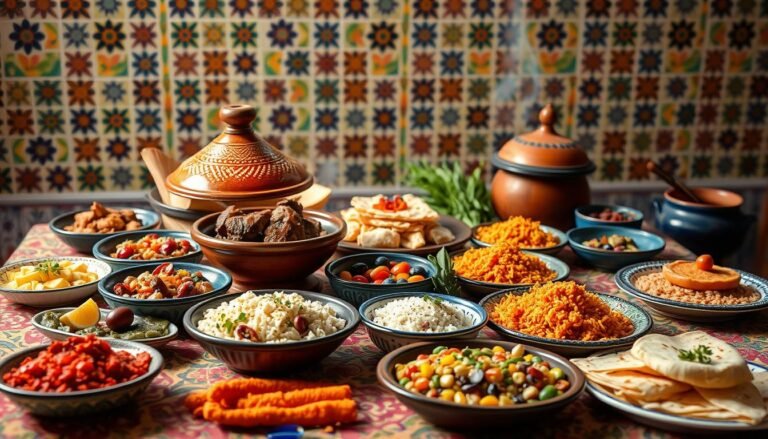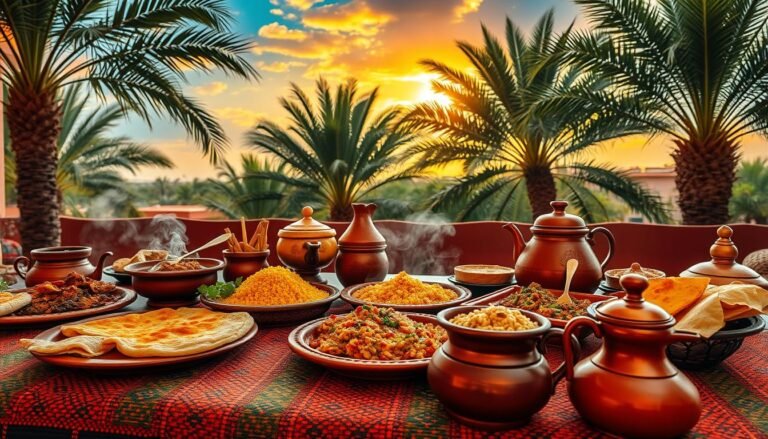Savor the Taste of Time-Honored Moroccan Tagine Dishes
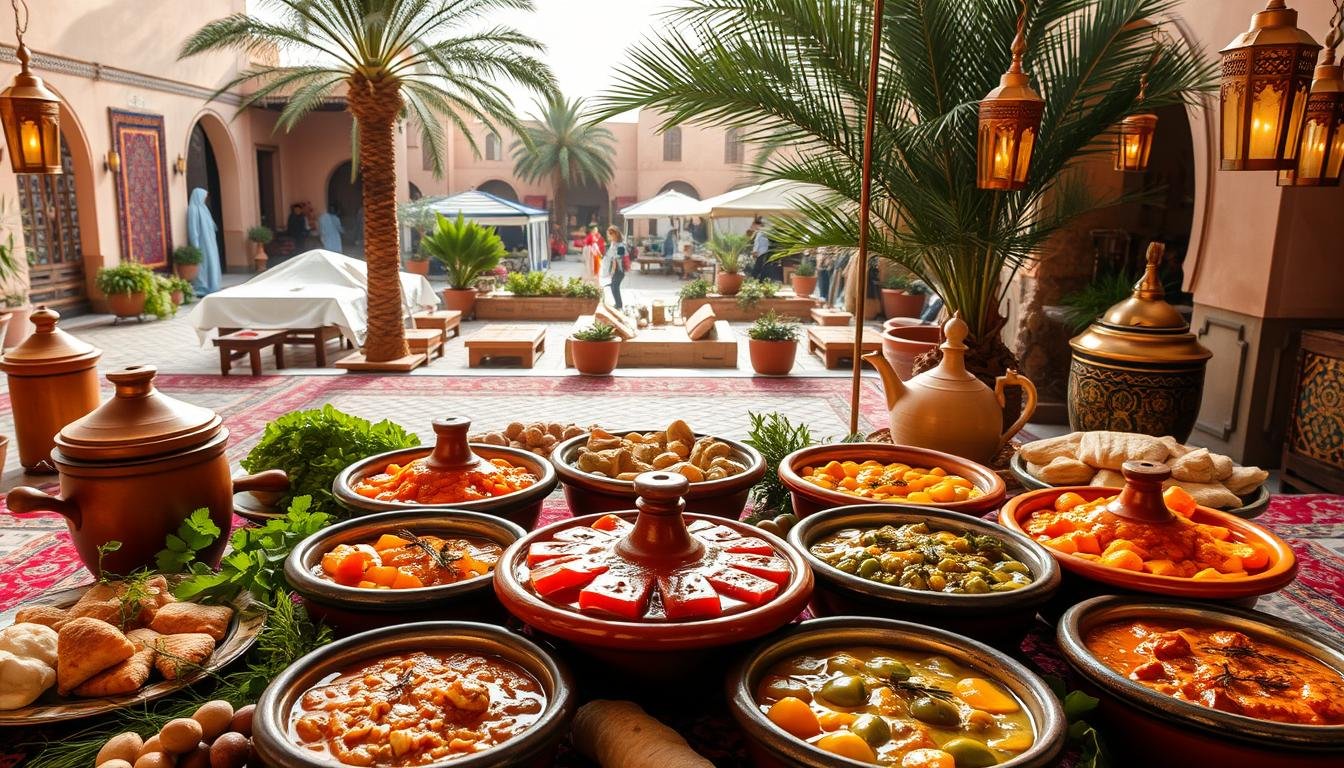
Imagine a culinary journey where every bite tells a story. Moroccan cuisine is more than just food—it’s a celebration of centuries-old traditions, vibrant flavors, and warm hospitality. From the aromatic spices to the intricate cooking techniques, every dish is a testament to the rich cultural heritage of this North African gem.
At its heart, Moroccan cuisine is a masterful blend of flavors. With up to 30 spices in its famous ras el hanout blend, each recipe is a symphony of sweet, savory, and spicy notes. This fusion is not just about taste; it’s about history, influenced by Berber, Arab, Andalusian, and Mediterranean cultures. Today, this timeless cuisine continues to captivate palates around the world, including in the United States, where its popularity grows steadily.
Whether you’re exploring the hearty tagines, the comforting couscous, or the delicate pastries, every Moroccan dish reflects a deep connection to the past. Join us as we delve into the fascinating world of Moroccan food, where every meal is a celebration of heritage, community, and the joy of sharing.
Key Takeaways
- Moroccan cuisine is a vibrant blend of flavors shaped by centuries of cultural influences.
- Spices like ras el hanout are central to creating the unique taste profiles of Moroccan dishes.
- Tagines and couscous are iconic dishes that reflect the country’s rich culinary heritage.
- Moroccan meals often emphasize communal dining and hospitality.
- The cuisine has gained global popularity, including in the United States, for its bold flavors and cultural depth.
Introduction to Moroccan Culinary Heritage
Moroccan cuisine stands as a testament to the country’s rich history and cultural diversity. This vibrant blend of flavors is deeply rooted in Morocco’s strategic location at the crossroads of Europe, Africa, and the Arab world. The unique cooking traditions of Morocco have been shaped by centuries of cultural exchanges, influenced by Andalusian Spain, Arabia, and even France.
At the heart of Moroccan cooking lies an extraordinary blend of spices. Ras el hanout, a signature spice mix, can include up to 30 different ingredients, creating a complex yet harmonious flavor profile. Staples like olives and tomato add depth to dishes, while the careful balance of sweet and savory notes reflects the country’s diverse heritage. These ingredients are not just about taste; they tell stories of trade routes, migrations, and cultural fusion.
Moroccan meals often emphasize communal dining and hospitality. “The act of sharing food is a celebration of life and togetherness,” as one local saying goes. This spirit of sharing is reflected in the preparation and presentation of every dish, from the intricate tagines to the hearty couscous. As we explore the authenticity of Moroccan ingredients and regional influences, we uncover a cuisine that is both timeless and endlessly inspiring.
The Essence of Moroccan Flavors and Spices
At the heart of Moroccan cuisine lies a vibrant tapestry of flavors, woven together by a carefully selected array of spices and ingredients. This section explores the key elements that define the unique taste of Moroccan cooking.
Key Ingredients and Traditional Aromatics
Moroccan cooking relies on a blend of aromatic spices and ingredients that create its distinctive flavor profiles. Cumin and coriander are staples, often used to add warmth and depth to dishes. Saffron, with its luxurious aroma, is sparingly used to enhance both flavor and color. Cinnamon, a sweet and versatile spice, is commonly found in tagines and stews, while ginger adds a subtle heat that balances the other flavors.
Signature Spice Blends in Our Recipes
The combination of these spices forms the backbone of Moroccan cuisine. Almonds are frequently used to add crunch and nutty flavors, particularly in dishes like tagines and salads. Ginger, with its spicy warmth, is a key ingredient in many slow-cooked stews, complementing the richness of meats and vegetables. Coriander, with its slightly citrusy notes, helps balance the heat in recipes, creating a harmonious blend of flavors.
These signature spice blends are what make Moroccan cooking so unique. By combining cumin, saffron, cinnamon, coriander, and ginger, we can recreate the authentic essence of Moroccan dishes in our own kitchens. Each spice plays a vital role, ensuring that every meal is a celebration of flavor and tradition.
Exploring Traditional Moroccan Dishes
Moroccan cuisine offers a diverse array of flavorful dishes that have been cherished for centuries. From hearty stews to delicate pastries, each creation reflects the country’s rich cultural tapestry.
At the heart of these recipes lies a harmonious balance of vegetables, lentils, and meat. This blend creates a symphony of flavors that cater to every palate. Whether it’s a slow-cooked tagine or a vibrant salad, every ingredient is chosen to enhance the overall dish.
Communal dining is a cornerstone of Moroccan meals. Sharing food fosters a sense of togetherness and hospitality. Simple ingredients like chickpeas, tomatoes, and spices are transformed into extraordinary meals through traditional cooking methods.
These timeless dishes set the stage for a deeper exploration of signature recipes and cooking techniques in the sections ahead.
Tagine: The Iconic Moroccan Cooking Pot
Tagine is more than just a cooking vessel; it’s a symbol of Moroccan heritage. This clay pot with a conical lid has been central to the country’s cuisine for centuries, allowing for slow-cooking that enhances flavors and textures. Whether in roadside cafés or upscale restaurants, tagine remains a beloved dish.
Chicken Tagine: A Comforting Classic
Chicken tagine offers a comforting experience with its savory flavors. Typically prepared with spices like saffron and cinnamon, the dish is both aromatic and delicious. The slow-cooking process ensures tender chicken in a rich sauce, making it a favorite for many.
Lamb Tagine: Rich and Hearty Variations
Lamb tagine provides a robust alternative, often featuring ingredients like dried fruits and nuts. The variations in ingredients, such as olives or preserved lemons, add layers of flavor. This dish is perfect for special occasions, offering a hearty and satisfying meal.
The tagine’s conical lid is key to its cooking process. It allows steam to condense and return to the pot, maintaining moisture and enhancing flavors. This method ensures that both chicken and lamb are tender and flavorful, creating a truly memorable dining experience.
Recreating tagine at home is achievable with the right pot and ingredients. Using aromatic spices and following traditional methods, you can enjoy authentic Moroccan flavors in your own kitchen. Whether chicken or lamb, each tagine dish tells a story of cultural richness and culinary artistry.
Couscous: A Staple of Moroccan Meals
Couscous holds a special place in every Moroccan meal, symbolizing hospitality and togetherness. This beloved staple is more than just a dish; it’s a cultural icon that brings people together.
Steaming Techniques and Flavorful Toppings
Couscous is traditionally prepared using a unique steaming technique. The process involves placing the couscous in a steamer basket over a flavorful stew. This method ensures the couscous absorbs the aromatic spices and broth, resulting in a light and fluffy texture.
The toppings and sides elevate couscous into a complete meal experience. Common additions include tender meats, a variety of vegetables, and a rich, spiced broth. This combination transforms a simple grain into a hearty and satisfying dish.
| Aspect | Preparation | Significance |
|---|---|---|
| Steaming | Using a couscoussier over a stew | Ensures fluffy texture and flavor absorption |
| Toppings | Vegetables, meats, and broth | Enhances nutritional value and variety |
| Serving | Friday meals and special occasions | Symbolizes hospitality and community |
Satisfying Soups and Stews
Soups and stews are the heart of comfort in Moroccan cuisine, offering warmth and nourishment. These dishes are crafted with care, blending flavors that comfort the soul and bring people together.
Harira: The Nourishing Ramadan Tradition
Harira stands out as Morocco’s most beloved soup, especially during Ramadan. This hearty blend combines tomatoes, lentils, chickpeas, and meat, creating a rich, comforting experience.
The magic lies in the spices—cumin, coriander, and a touch of harissa. These ingredients create a balanced flavor that’s both soothing and aromatic, making Harira a cherished tradition during Ramadan.
Sharing a bowl of Harira is more than a meal; it’s a communal ritual. Families and friends gather to break their fast, savoring the warmth and togetherness that this soup embodies.
Moroccan Street Food Adventures
Step into the vibrant streets of Morocco, where every corner offers a flavorful adventure. Street food here is more than just a quick bite—it’s a cultural experience that connects you with the heart of the country.
Makouda and Other Savory Bites
Makouda, a beloved street snack, stands out with its crispy, deep-fried potato balls. Served with a spicy dip, it’s a must-try that perfectly captures the essence of local flavors. The combination of golden, crunchy exteriors and soft interiors makes Makouda irresistible.
Wander through bustling marketplaces like Marrakech’s Djemaa el-Fna square, and you’ll be greeted by a symphony of sights, smells, and tastes. From sizzling grilled meats to aromatic spices, every stall offers something unique. The street food scene here is a celebration of diversity, with options ranging from savory bites to unique local specialties.
When exploring these culinary delights, remember to choose busy stalls for freshness and safety. Take your time to savor each bite—street food in Morocco is not just about eating; it’s about experiencing the culture. Whether it’s Makouda or other treats, every flavor tells a story of this vibrant land.
Vibrant Salads and Dips in Moroccan Cuisine
Moroccan cuisine is a feast for the senses, and its salads and dips are no exception. These vibrant creations add a fresh and zesty touch to any meal, making them a delightful start or accompaniment to main dishes.
One of the standout salads is Taktouka, a roasted bell pepper and tomato salad. Made with roasted bell peppers, fresh tomatoes, garlic, and olive oil, Taktouka is a flavorful and healthy option. It’s often served at gatherings and parties, showcasing its social significance. This salad is versatile, enjoyed warm or cold, and fits various dietary preferences like vegan and gluten-free.
Zaalouk, a smoked eggplant dip, offers a rich and savory experience. With a focus on eggplant, this dish is prepared in a one-pan method and can be served warm, at room temperature, or cold. Both Taktouka and Zaalouk highlight the use of lemon, which brightens and balances their flavors, adding a refreshing note to these dishes.
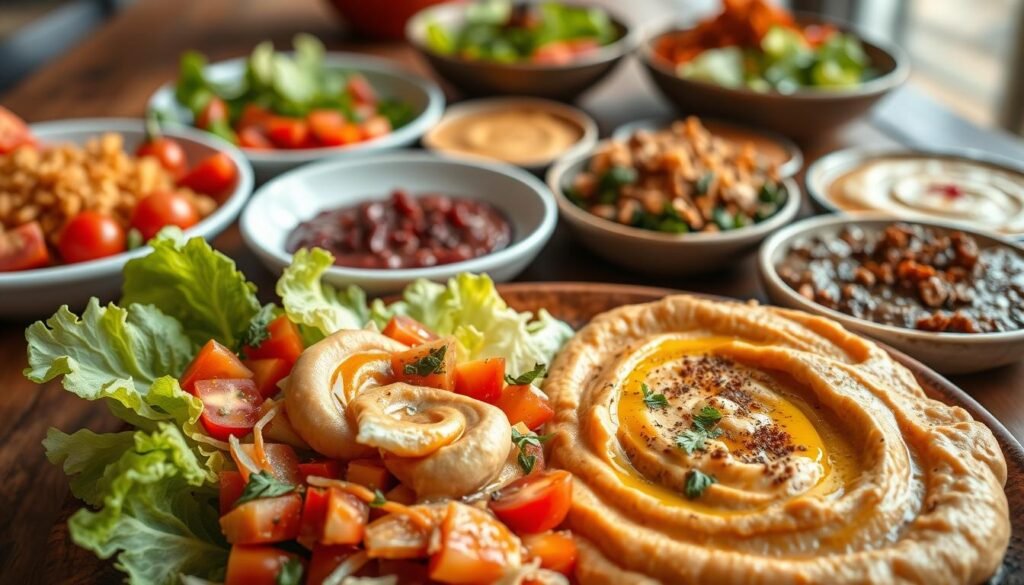
These salads and dips not only reflect Morocco’s culinary diversity but also its cultural richness. They are more than just food; they are a celebration of community and togetherness, often served during special occasions like Ramadan. Whether as an appetizer or a side, they enhance the meal with their vibrant colors and bold flavors, embodying the spirit of Moroccan hospitality.
B’stilla and Specialty Pies of Morocco
B’stilla, a masterpiece of Moroccan culinary art, is a delicate pastry that encapsulates a rich tapestry of flavors. This specialty pie is renowned for its intricate layers of paper-thin pastry, which cradle a savory filling of chicken or pigeon, almonds, and eggs. The harmony of sugar and cinnamon adds a unique sweet-savory charm, making it a standout dish in any setting.
Layers of Flavor in Exquisite Pastillas
The preparation of B’stilla is an art form. Thin sheets of pastry are layered to create a flaky, golden crust. The filling, a blend of tender meat, crunchy almonds, and eggs, is seasoned with a mix of spices, including cinnamon, creating a delightful balance of flavors. This dish is often served at festive occasions, reflecting its cultural significance and the joy of communal dining.
B’stilla is a testament to the skill and patience of Moroccan chefs. Each layer of pastry and the meticulous preparation of the filling highlight the craftsmanship behind this beloved dish. Whether served at a celebration or a family gathering, B’stilla continues to enchant palates with its exquisite flavors and historical charm.
Seafood Sensations: From Chermoula to Grilled Fish
Discover the vibrant coastal flavors of Morocco, where the ocean’s bounty meets aromatic spices. Seafood plays a significant role in Moroccan cuisine, especially along the coast, where fresh fish is a staple.
At the heart of these seafood dishes is chermoula, a zesty marinade made with garlic, fresh herbs, and spices. This flavorful blend adds a bright, aromatic note to grilled or baked fish. The marinade typically includes coriander, lemon juice, and a hint of chili, creating a perfect balance of acidity and warmth.
Grilling is a popular cooking method for fish in Morocco. The process enhances the natural flavors of the seafood while infusing a smoky, charred texture. Whether it’s a firm white fish or a delicate fillet, the result is tender and flavorful, often served with a side of couscous or roasted vegetables.
| Aspect | Details | Significance |
|---|---|---|
| Marinating Time | Minimum 2-3 hours, best overnight | Ensures deep flavor absorption |
| Serving Size | Typically serves 6 people | Perfect for family or group meals |
| Cooking Time | Approx. 3 hours 10 minutes | Includes prep and cook time |
Recreating these seafood sensations at home is easier than you think. With a few simple ingredients and traditional techniques, you can bring the flavors of Morocco’s coast to your kitchen. Whether you’re grilling fish or baking it, the key is to let the marinade work its magic. So, dive into the world of Moroccan seafood and savor the taste of the ocean, seasoned with the warmth of North African spices.
Sweets, Teas, and Traditional Desserts
Moroccan cuisine is a symphony of flavors, and its desserts and teas are no exception. These sweet treats are not just endings to meals but celebrations of tradition and hospitality.
Mint Tea: The Moroccan Beverage Ritual
Mint tea, often referred to as “Moroccan whisky,” is a cherished beverage that embodies the spirit of Moroccan hospitality. The preparation is an art form, beginning with the selection of fresh mint leaves and gunpowder tea. The process involves steeping the tea, adding mint, and then carefully pouring it to create the signature frothy crown.
Sugar plays a vital role in balancing the flavors, making each sip a delightful experience. This sweet and refreshing drink is more than just a beverage; it’s a symbol of welcome and community. Whether in casual gatherings or formal celebrations, mint tea is always at the heart of Moroccan social life.
The cultural significance of mint tea extends beyond its taste. It’s a ritual that brings people together, fostering connections and warmth. As we explore the world of Moroccan sweets and teas, we find a perfect blend of tradition and exquisite taste that continues to enchant palates worldwide.
The Evolution of Culinary Techniques in Morocco
Imagine a fascinating journey through time, where centuries-old culinary methods meet modern innovations. Moroccan cuisine has gracefully evolved, blending traditional practices with contemporary techniques to create exciting new versions of beloved recipes.
At the heart of this evolution is the balance between innovation and tradition. Classic dishes now incorporate fresh ingredients and modern cooking methods while retaining their authentic flavors. For instance, the slow-cooked tagine, traditionally prepared in clay pots, is now often made with modern appliances that maintain the dish’s signature tenderness and flavor depth.

One of the most significant advancements is the use of tomato in creating rich, flavorful sauces. This ingredient, though not originally part of traditional Moroccan cooking, has become a staple in many modern recipes, adding a vibrant twist to classic dishes. The integration of tomato reflects how Moroccan cuisine adapts to global influences while preserving its cultural essence.
Contemporary chefs are also experimenting with new versions of traditional recipes. For example, vegetarian and vegan adaptations of classic dishes are gaining popularity, offering innovative takes that cater to diverse dietary preferences. These modern interpretations highlight the versatility of Moroccan cuisine while staying true to its roots.
The evolution of culinary techniques in Morocco is a testament to the country’s ability to embrace change without losing its cultural identity. By harmonizing traditional methods with modern innovations, Moroccan cuisine continues to captivate palates worldwide, offering a delicious blend of history and creativity in every dish.
Recipes and Home Cooking Adaptations
Bringing the essence of Moroccan cuisine into your home kitchen is easier than you might think. With a few simple tweaks, you can turn classic recipes into modern masterpieces that resonate with today’s tastes and dietary preferences.
Modern Twists on Classic Dishes
One of the joys of cooking is the freedom to innovate. Take the beloved chicken tagine, for instance. While traditional recipes call for slow-cooking in a clay pot, you can achieve similar results using a slow cooker or even an Instant Pot. Add a modern flair by incorporating ingredients like quinoa or roasted vegetables for added texture and nutrition.
Another idea is to give your favorite food recipes a contemporary twist. For example, substitute traditional meats with plant-based alternatives or use gluten-free spices to cater to diverse dietary needs. These small changes can make classic dishes feel fresh and exciting without losing their authentic flavor profiles.
Practical Tips for the At-Home Chef
Recreating complex flavors at home doesn’t have to be intimidating. Start by experimenting with pre-mixed spice blends like ras el hanout, which can elevate your dishes with minimal effort. Don’t shy away from substitutions—swap out ingredients like olives for capers or preserved lemons for a tangy twist.
Keep it simple by focusing on versatile ingredients. Chickpeas, for example, can be used in everything from hearty stews to crispy snacks. The key is to let your creativity shine while staying true to the essence of the recipe.
| Aspect | Modern Adaptation | Benefit |
|---|---|---|
| Spice Blends | Use pre-mixed ras el hanout | Convenient and time-saving |
| Protein | Substitute chicken with tofu or legumes | Caters to vegetarian/vegan diets |
| Ingredients | Swap olives for capers | Adds a unique briny flavor |
Remember, the beauty of cooking lies in experimentation. Encourage yourself to try new combinations and share your creations with friends and family. The more you cook, the more you’ll discover how easy it is to bring a taste of Morocco into your home.
North African Influences and Global Fusion in Moroccan Cuisine
North African influences have shaped the vibrant flavors of Moroccan cuisine, creating a unique blend of local and global elements. This culinary landscape reflects a rich history of trade and cultural exchange, blending spices, ingredients, and techniques from various regions.
At the heart of this fusion are ingredients like olives, which add a distinctive brininess to many dishes. The diverse spice blends, such as ras el hanout, further showcase this cultural melting pot. These elements embody the fusion of traditions, creating a flavor profile that is both familiar and exciting.
Global fusion dishes now incorporate Moroccan elements, offering creative twists. For example, Moroccan-inspired sushi rolls with spiced tuna or lamb tacos with chermoula highlight this modern culinary approach. These innovations celebrate both time-honored traditions and contemporary creativity.
| Aspect | Traditional Elements | Modern Fusion |
|---|---|---|
| Ingredients | Olives, ras el hanout | Spiced tuna, chermoula |
| Techniques | Slow-cooking in tagines | Grilling, sushi rolls |
| Dishes | Tagines, couscous | Moroccan sushi, lamb tacos |
This blend of North African influences and global trends highlights Moroccan cuisine’s adaptability and richness, making it a beloved choice worldwide.
Celebrating Moroccan Food: Tips for Authentic Flavors
Discover the secrets to crafting authentic Moroccan flavors in your kitchen with these expert tips. Balancing bold spices with subtle accents is key to recreating the vibrant taste of Morocco.
Fresh ingredients are the foundation of Moroccan cooking. Tomatoes add a burst of freshness to sauces, while eggs provide richness in dishes like shakshuka. For an extra layer of complexity, incorporate coriander, which brightens flavors with its citrusy notes.
| Ingredient | Use | Tip |
|---|---|---|
| Tomatoes | Enrich sauces | Use fresh for best flavor |
| Eggs | Add richness | Perfect for shakshuka |
| Coriander | Brighten dishes | Use in spice blends |
Experiment with coriander in your spice blends for a authentic touch. Remember, the joy of cooking lies in creativity while maintaining the essence of Moroccan cuisine.
Conclusion
As we conclude our culinary exploration, we reflect on the rich tapestry of flavors that define Moroccan cuisine. From hearty meat tagines to refreshing salads, each dish tells a story of cultural heritage and hospitality.
The simplicity of ingredients like bread and oil plays a vital role in creating memorable meals. These elements, combined with a squeeze of lemon, bring out the vibrant flavors that make Moroccan cooking so unique.
Whether it’s a weeknight dinner or a special occasion, incorporating these timeless techniques into your daily cooking can elevate any meal. The beauty of Moroccan cuisine lies in its adaptability and depth, making it easy to enjoy any day of the week.
We invite you to embrace the complexity and charm of Moroccan flavors. Let every meal be a celebration of this captivating cuisine, where each bite is a testament to its enduring legacy.

